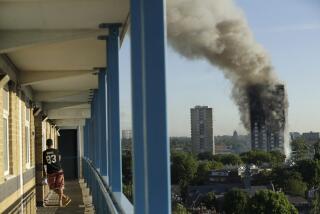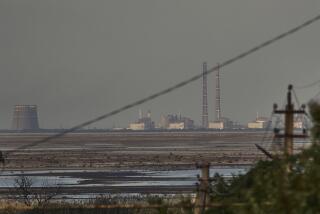Soviets Gaining Control at Chernobyl, Panel Says
- Share via
MOSCOW — Officials of the U.N. atomic energy agency said Friday that the Chernobyl disaster is by far the worst nuclear accident in history, but Soviet experts are getting it under control.
They said radiation still leaks slowly from the nuclear power plant’s stricken No. 4 reactor, but the fire in its graphite core has been stopped and the Soviets will “entomb” it in concrete for a cooling process that will take years.
Based on their observations and Soviet data, “It’s clear . . . that the radioactive consequences of this accident are far more serious than in any accident so far, also that the radioactive releases to the environment are much more serious,” Hans Blix, chief of the International Atomic Energy Agency, told a news conference.
Blix and his deputies said temperatures in the graphite core were dropping and uncontrolled downward burning of the nuclear fuel, commonly called the “China syndrome,” is not an immediate threat.
An explosion and fire in the reactor at the Ukrainian plant April 26 spewed an invisible radioactive cloud over Europe that gradually has been working its way around the world.
No other governments reported health-threatening levels of radiation Friday.
After his group returned to the IAEA headquarters in Vienna Friday, Blix said the Soviets had agreed to provide daily radiation readings from seven stations along their western border from the northern city of Leningrad to the Black Sea. These are to be relayed to national nuclear authorities, but not made public.
About 84,000 residents within an 18-mile radius of the plant were evacuated beginning 36 hours after the disaster. About 250,000 children are being let out of school early so they can leave Kiev, the Ukrainian capital of 2.4 million people 80 miles south of Chernobyl.
Journalists from Eastern Europe said a Soviet official told them a third person had died as a result of the accident. Official reports have said two people were killed and 204 hospitalized, 18 in serious condition.
An American bone-marrow specialist leads a team of doctors performing marrow transplants in Moscow on victims of severe radiation exposure.
No New Information
The Kremlin made its sixth official statement on the disaster Friday evening, which consisted of three paragraphs and gave no new information.
All but one statement have been brief. The first, reporting the accident, was issued two days after it occurred, when high radiation levels were detected in Scandinavia, prompting Sweden to demand information.
Western governments have criticized the Soviet government for slow and incomplete reports on the disaster.
The first foreign journalists allowed to visit the Ukraine were escorted to a farm 31 miles west of Kiev where 1,000 evacuees are housed. They were shown medical checks being given and allowed to speak with a few evacuees, all of whom appeared to be in good health.
“I took some things, two or three little blankets and pillows,” said Marina Ilchenko, 80. She began to weep as she related that she and her children had just moved into a new house.
The people evacuated took their livestock along.
Blix and his associates spoke to reporters in Moscow after five days of meetings with Soviet officials.
Satisfied With Reports
Asked if he was satisfied with information the Soviets provided, Blix replied: “Emphatically, yes.”
Morris Rosen, an American who is the U.N. agency’s nuclear safety director, described the Soviets coordinating the cleanup as “competent and well-qualified.”
Blix, Rosen and the U.N. agency’s Soviet deputy director, Leonard Konstantinov, flew half a mile from the damaged reactor Thursday.
“There are relatively little radioactivity releases now and the temperatures (in the No. 4 reactor) are decreasing. The situation appears to be stabilizing,” Rosen said.
He said there had been no meltdown in the reactor’s core, which contradicts the view of many American nuclear authorities.
Robert Avery, a senior scientist at Argonne National Laboratory in Illinois, said in an interview Friday: “It would be unreasonable to imagine a huge amount of (radioactive) material getting out--as it apparently did--without there being a meltdown.”
Rosen said his view that a meltdown did not occur was based in part on an analysis of the radioactive materials released.
He said the conclusion that the core fire was out was based in part on declining temperatures reported by Soviets after infrared measurements.
Videotape Made
During the flight Thursday, he said, they saw a small amount of light gray smoke coming from the tons of sand, boron, lead and dolomite now covering the reactor.
A Soviet videotape of the plant made a few days after the accident showed dense, black smoke coming from the graphite fire, Rosen said, and the lighter smoke appeared to come from smoldering material in the “shield” dumped by helicopters.
Soviet engineers are working under the reactor, pouring concrete that “eventually will form a foundation to entomb the structure,” he said.
Rosen said the engineers could get under the reactor by tunneling or entering through the building housing the adjacent No. 3 reactor, which he said was not damaged and is shut down like the other two at the plant.
Rosen called the concrete encasement “probably a reasonable approach” that will allow the reactor to cool “as the years go by, and eventually to a level which should cause no concern.”
The agency’s safety director was asked repeatedly whether there was danger of a meltdown or uncontrolled downward burning.
“As a matter of physics, it is not completely excluded,” he said. “However, the chain reaction (in the reactor) stopped immediately after the accident and never started again.”
Possible resumption of the chain reaction “is not considered a problem,” he said.
Wouldn’t Speculate on Cause
He would not speculate on what caused the accident, and said he did not have enough information to say how much of the reactor’s radioactivity was released.
Rosen did say, however, that most of the radioactive particles had short half-lives, the period required for half of a radioactive substance’s atoms to disintegrate and make it less dangerous.
Soviet reports say 50% of the radioactive substance vented was iodine 131, which has a half-life of eight days, Rosen said. He added that “the accident area will be habitable again,” but did not predict when.
More to Read
Sign up for Essential California
The most important California stories and recommendations in your inbox every morning.
You may occasionally receive promotional content from the Los Angeles Times.













